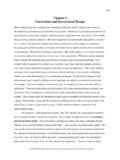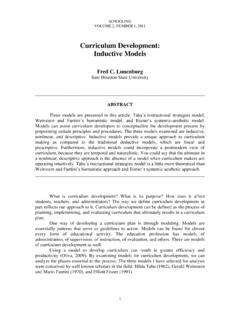Transcription of Chapter 4 Instructional Methods and Learning Styles
1 125. Chapter 4. Instructional Methods and Learning Styles How do we factor the variability of students into our Instructional Methods ? All students are different, and yet there are many commonalties from student to student. Should students simply design their own education, an education that theoretically would be tailored to their needs? Should students be left to their own desires and needs, as Rousseau advocated in Emile in the late 1700s and as A. S. Neill advocated in Summerhill in the 1960s? Or are there ideas and Methods that all students should simply endure, for the good of the social system? We have learned quite a bit about accommodating the variability of students through research into Instructional Methods and Learning Styles . If we vary our Methods , we have learned, we accommodate a wider range of Learning Styles than if we used one method consistently.
2 Teaching Methods are the complement of content, just as instruction is the complement of curriculum . Technology teachers tend to over-use projects and problems, ignoring the options and opportunities that the balance of teaching Methods offers. In this time of global hazards and changes in our lives wrought by technology, it is essential that technology teachers maintain a refined sense of how to teach about controversial and sensitive technological issues. It is essential that technology teachers have a command over values clarification Methods as well as demonstration and project Methods . Given that technology teaching Methods are often research-driven, twenty-two research Methods are outlined in this Chapter . Forty-one teaching Methods are defined and five that are central to technology studies are explained in detail.
3 The Chapter concludes with detailed sections on the relationships among Instructional Methods , personalities and Learning Styles . Instructional Systems Think systemically about instruction. Systems involve relationships, conditions, processes, causes, effects and feedback. To identify a system, we must demarcate where one system ends and another begins. In education, as in ecosystems, this is done somewhat arbitrarily. For example, if we identify and focus on an Instructional system, we necessarily bracket out the Learning system. We make some system components visible and leave others invisible. We identify an Instructional system at the peril of ignoring other systems or bracketing too narrowly. What is involved in the process of instruction? What are the essential components of instruction? Instructional systems involve decisions related to what will be taught, how it will be organized for Learning and how Learning will be assessed.
4 For analytical purposes it is necessary to identify what students and teachers do within the system. It is important to address individual components of the system. While there are components that are overlooked, the diagram below generally represents an Instructional system. Events of instruction, such as an activity, demonstration or presentation Stephen Petrina. (in press). curriculum and Instruction For Technology Teachers 126. require that teachers attend to all of the components within the system. Instructional planning unfolds quite procedurally, but not necessarily in the linear fashion below (Fig. ). Determination of Instructional Specification of Strategy Content Organisation of Groups Assessment of Allocation of Evaluation of Entering Time Performance Behaviours Allocation of Learning Space Specification of Objectives Selection of Analysis of Resources Feedback Figure Instructional System The intention of this diagram is not to suggest that you ought to identify and memorize the components of an Instructional system.
5 Rather, one intention is to help you grasp the scope of an Instructional system and its complexities. A second is to demonstrate the interrelations among components of an Instructional system. When we alter a component within the system, we change the conditions for all the components. We alter the process of instruction. A third is that while we may isolate an Instructional system, we do not eliminate the interrelations among this system and others. When we alter Instructional systems, we alter Learning systems as well. Instructional systems are not built in stone. They are malleable. Hence, if there are problems and issues that are systemic rather than consequential to the system, the system can be altered. These are the most important lessons to take from our recommendation to think systematically about instruction.
6 In the first Chapter , we approached the subject of communication and Instructional planning holistically. Invoking our cycle of experience, we suggested that the best way to learn how to teach is to teach. The best way to learn how to teach technology studies is to learn how to demonstrate. Demonstrations involve all of the components of an Instructional system. Instead of breaking down a demonstration into separate components, we approached it as a whole entity. However, we also dealt with Instructional objectives in an isolated, albeit focused, way. In the remainder of this Chapter , we address Instructional Methods , teaching Styles and Learning Styles . Stephen Petrina. (in press). curriculum and Instruction For Technology Teachers 127. Teaching Methods General models and families of teaching Methods are guides for designing educational activities, environments and experiences.
7 They help to specify Methods of teaching and patterns for these Methods . Instructional strategies, or teaching Methods , depend on a number of factors such as the developmental level of students, goals, intent and objectives of the teacher, content, and environment including time, physical setting and resources. Imagine a course that challenges teachers to meet a number of objectives. A single method cannot meet all of our goals nor can a single method accommodate all Learning Styles at once. For example, demonstrations or projects are effective for meeting some goals but ineffective for meeting others. So we need a toolbox of Methods , not merely a single tool. In the most general terms, there are four or five different models of Instructional strategies or teaching Methods . Having spent years in schools, you will recognize each and probably have strong preferences for one or two models.
8 Didactic- Direct teaching; Verbal and typically in the form of a lecture or presentation. Modeling- Direct teaching; Visual and typically in the form of demonstration and practice. Managerial- Indirect or Interactive teaching; Facilitation, individualization and group management. Dialogic- Indirect Interactive teaching; Socratic Technique of dialogue, questions and thought provocations. In the Direct Instruction models, the teacher imparts knowledge or demonstrates a skill. In the Indirect Instruction models, the teacher sets up strategies, but does not teach directly; the students make meaning for themselves. In the Interactive Instruction models, the students interact with each other and with the information and materials; the teacher is organizer and facilitator. Experiential Learning models mean that the students experience and feel; they are actively involved.
9 In Independent Study models, the students interact with the content more or less exclusive of external control of the teacher. Some theorists prefer to reduce these to three general Methods : Transmissive, transactive and transformative teaching. Transmissive teaching, or direct instruction, means that the teacher delivers status quo content via some method such as lecturing or demonstrating. Transactive teaching, or indirect instruction, means that the teacher and students arrive at status quo content to be learned though transactions and dialogue. Transformative teaching, or a combination of direct and indirect instruction, means that the teacher and students reject status quo content and focus on a transformation of themselves or their world. Stephen Petrina. (in press). curriculum and Instruction For Technology Teachers 128.
10 These general models help us to classify teaching Methods and simplify our discourse for conversing about them. We also group Methods by their "family" affiliations. Some Methods lend themselves to encouragement of social interaction in students. Other Methods encourage information processing and some facilitate behavioral modification. Still others support intrapersonal and interpersonal development. Each of these families offers different approaches to teaching, respond to different objectives and goals, and yield different results in students. Four Families of Teaching Methods (Joyce & Weil). Social Interaction Family- Emphasizes the relationship of the individual to society or to other persons. Gives priority to the individual's ability to relate to others. o Partner and Group Collaboration o Role Playing o Jurisprudential Inquiry Information Processing Family- Emphasizes the information processing capability of students.




